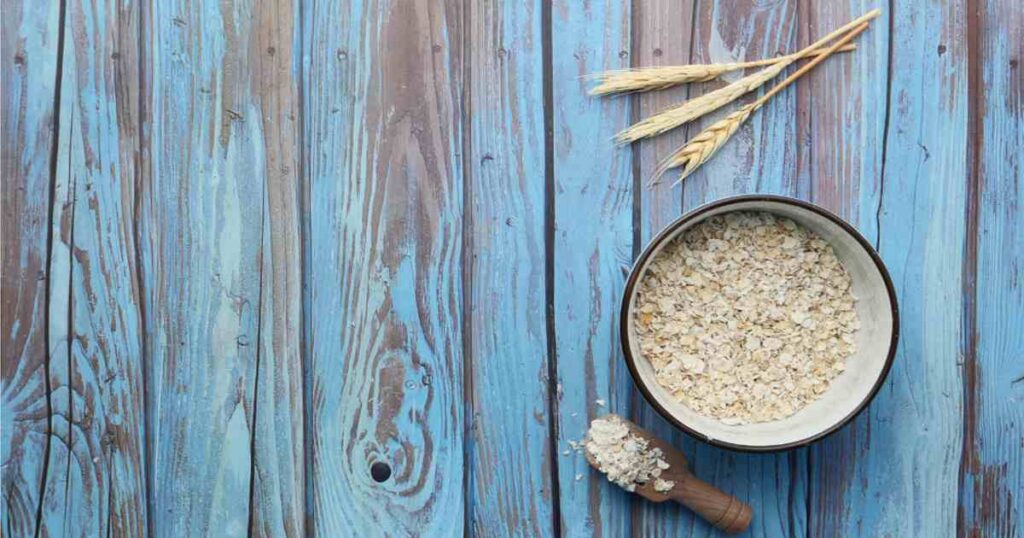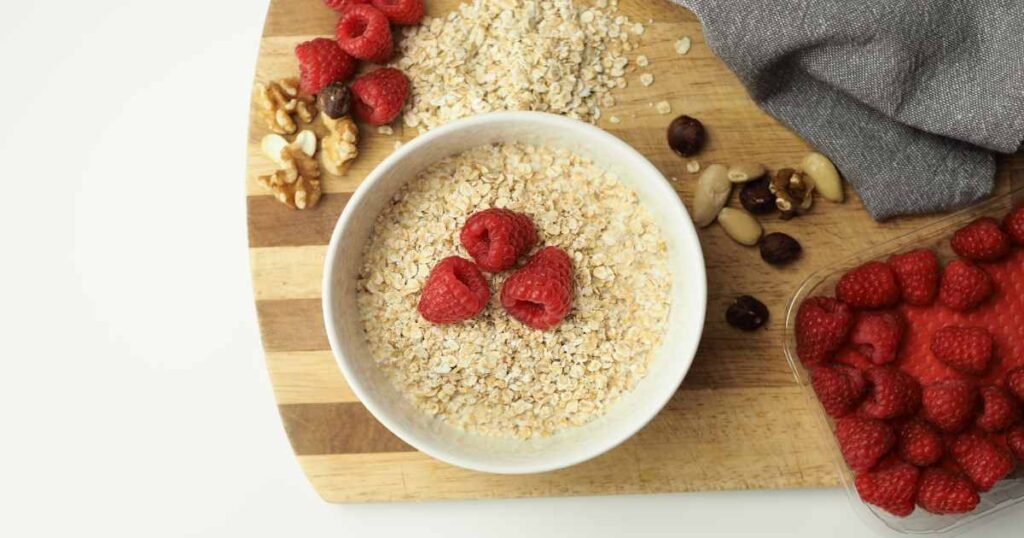
It’s no secret that oatmeal has been a popular go-to for decades, but don’t guess on the exact amount because too much can lead to constipation and there’s a sweet spot when it comes to how much oatmeal you should eat to lose weight.
In general, that sweet spot is half a cup or 50 grams of uncooked oats per day is ideal for weight loss purposes. While this amount is also enough to reap the other health benefits (less cholesterol, healthy microbiome, preventive against diabetes and heart disease) associated with oats.1, 2, 3
Can You Eat Too Much Oatmeal on a Weight Loss Diet?
Moderation and balance are key in any diet so eating too many oats is surely possible. Technically you could eat up to 900 calories worth (or 200 grams) in a day according to USDA guidelines.4, 5, 6 But eating too much oatmeal in a short time can lead to excessive bloating, make you feel weighed down and sluggish too.
Even eating an entire cup of oats in one sitting is only advised in a diet of over 2500 calories, and even then, it is something that should be worked up to and may be better off broken up into 2 separate meals.
Before jumping off the deep end and buying all the oats you can find, consider some of the best weight loss cereals for variety or grains and nutrients too.
How Much Oatmeal a Day is Too Much?
“Too much” is subjective due to different caloric needs, but we can take the USDA guidelines as a general rule of thumb.
For individuals aged 14 and older, the USDA recommends eating 6 ounces of grains daily. Half of these should come from whole grains (grains that contain the entire grain kernel), and half are allowed to come from refined grains.7 The ounce equivalent is up to 3 cups of cooked oatmeal or 150 grams of dry oats, but this would include too much fiber and would miss out on the benefits of variety.8 With this knowledge, it is safe to say that anything over 2 servings is likely too much for weight loss and anything over 6 servings is over USDA recommendations.
We recommend adhering to these figures because a diet lacking in variety fails to supply a broad range of essential nutrients the body requires.9 Having established the daily limit for oatmeal, let’s consider its suitability as a staple meal.
Is it Ok to Eat Oatmeal Every Day?
The easy answer to this question is yes- it is ok to eat oatmeal every day. In moderation, oatmeal is a great choice for weight loss, but with all the whole grain options available, it’s a good idea to mix it up while making sure to avoid refined grains.
While eating oatmeal every day is perfectly acceptable and even quite healthy, a new trend called the oatmeal diet has surfaced, taking it to another level. This diet centers on eating oatmeal every day, three times a day, and promises to help the user shed pounds quickly. This diet gained momentum with its three-part process.
- In phase one, oatmeal is eaten three times a day with no additional foods.
- Phase two allows for the addition of some fruits and vegetables while still eating oatmeal three times a day.
- Finally, in phase three the diet resumes a regular balanced routine but oatmeal still makes up one meal a day.
While the oatmeal diet shows promising results in the short term, it’s not a diet that can be maintained realistically as there is more to losing weight than just eating less. Restricting diets such as this can often result in rapid weight gain as soon as they are over due to the negative impact that these limitations create.10, 11
Making Oatmeal for Weight Loss

Quantity: When making oatmeal for weight loss purposes, one serving is probably enough for most and you get 150 calories, 33 grams of carbohydrates, 5 grams of mostly soluble fiber, and 6.5 grams of protein from that alone.
Toppings: On top of the serving size, it’s important to remember that while oatmeal can lower bad (LDL) cholesterol, if your topping choices aren’t added with careful consideration, your healthy meal can turn into an indulgent one.
Therefore, some healthy topping choices include:
- Cinnamon
- Fruit
- Nuts or nut butter
- Yogurt
- Skim milk
- Chia seeds
- Flax seeds
- Pumpkin
- Egg
Don’t be afraid to literally spice it up if you get bored of these toppings.
Types: In addition, some types of oats are more wholesome than others, but even minute oats are healthy. With that being said, here’s a few types of oats from most-least healthy.
- Steel-cut oats
- Scottish oats
- Rolled oats
- Minute oats
No matter the type of oats and as long as they’re not prepared with tons of sugar, oats are such a versatile weight loss food. They can be added to meat-based meals to give more bulk, put in smoothies raw (raw oats have more fiber), and made into healthy granola bars.12
Once you know how much oatmeal to eat for weight loss, you can easily incorporate it into just about any meal.
In Summary
Since oatmeal is loaded with healthy fiber, complex carbs and protein it can be difficult to figure out how much oatmeal you should eat to lose weight. But now you should understand that a balanced diet can safely and effectively allow for 50-100 grams (1/2-1 cup) of uncooked oats daily and should never exceed 300 grams (3 cups).
While eating oatmeal will provide you with long-lasting energy, keep you full longer, and help lower cholesterol, there are many other weight loss solutions to consider. Instead, incorporate a variety of whole grains into your diet to provide a wider range of nutrition. Now that you know how much oatmeal to eat to lose weight, you can effectively incorporate oats into your diet to live a healthier, more balanced life.
References
1KS;, K. R. K. M. S. (2020, May). Effects of oats on gastrointestinal health as assessed by in vitro, animal, and human studies. Nutrition reviews. Retrieved January 11, 2022, from <https://pubmed.ncbi.nlm.nih.gov/31638148/>
2Oats. The Nutrition Source. (2021, July 6). Retrieved January 8, 2022, from <https://www.hsph.harvard.edu/nutritionsource/food-features/oats/>
3PJ;, O. R. A. M. M. H. J. (2011). Cholesterol-lowering effects of oat β-glucan. Nutrition reviews. Retrieved January 6, 2022, from <https://pubmed.ncbi.nlm.nih.gov/21631511/>
4Wikimedia Foundation. (2021, December 20). Rolled oats. Wikipedia. Retrieved January 7, 2022, from <https://en.wikipedia.org/wiki/Rolled_oats>
5Your MyPlate Plan – 2000 calories, ages 14+ years. MyPlate. (2020). Retrieved January 6, 2022, from <https://www.myplate.gov/myplate-plan/results/2000-calories-ages-14-plus>
6USA.gov. (2020). Grains. MyPlate. Retrieved January 8, 2022, from <https://www.myplate.gov/eat-healthy/grains>
7Gaesser, G. A. (2019, May 1). Perspective: Refined grains and health: Genuine risk, or guilt by association? Advances in nutrition (Bethesda, Md.). Retrieved January 6, 2022, from <https://www.ncbi.nlm.nih.gov/pmc/articles/PMC6520038/>
8Harvard Chan School. (2019, November 4). Whole grains. The Nutrition Source. Retrieved January 11, 2022, from <https://www.hsph.harvard.edu/nutritionsource/what-should-you-eat/whole-grains/>
9Better Health Channel. (2021, December 16). Healthy eating. Healthy eating – Better Health Channel. Retrieved January 6, 2022, from <https://www.betterhealth.vic.gov.au/health/healthyliving/healthy-eating>
10Cava, E., Yeat, N. C., & Mittendorfer, B. (2017, May 15). Preserving healthy muscle during weight loss. Advances in nutrition (Bethesda, Md.). Retrieved January 11, 2022, from <https://www.ncbi.nlm.nih.gov/pmc/articles/PMC5421125/>
11U.S. National Library of Medicine. (1996, June). Psychological consequences of food restriction. Journal of the American Dietetic Association. Retrieved January 6, 2022, from <https://pubmed.ncbi.nlm.nih.gov/8655907/>
12Wikimedia Foundation. (2021, June 1). Talk:oatmeal. Wikipedia. Retrieved January 6, 2022, from <https://en.wikipedia.org/wiki/Talk%3AOatmeal>